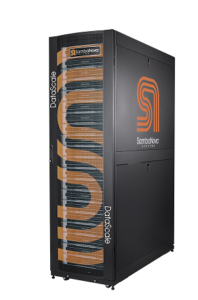AI Vendor SambaNova and Its $676M in New Funding Is Taking on Nvidia

With a fresh war chest of $676 million in its latest Series D funding round, AI platform vendor SambaNova Systems now intends to grow its workforce by 40 percent by the end of 2021 and put AI market leader Nvidia directly in its crosshairs.
That’s the central mission laid out for the company by Rodrigo Liang, co-founder and CEO of SambaNova after the company announced its latest funding success on April 13 (Tuesday).
The new investment comes from the SoftBank Vision Fund 2, as well as from first-time investors Temasek and GIC, plus existing backers including funds and accounts managed by BlackRock, Intel Capital, GV (formerly Google Ventures), Walden International and WRVI, according to SambaNova. With the latest large cash infusion, SambaNova says it now has total funding of more than $1 billion and a valuation above $5 billion.
“SambaNova will use this latest injection of capital to aggressively challenge the incumbent legacy competitor in the market, Nvidia,” Liang told EnterpriseAI. “The company plans to grow from 300+ to 500 employees by the end of the calendar year across all functions including engineering, go-to-market and general and administrative expenses, while expanding beyond the North America and EMEA markets it already serves through regional presence.”
The company intends to further challenge Nvidia in the systems space after Nvidia rolled out its second-generation, AI-targeted, DGX Station A100 server last November.
While Nvidia's GPUs have historically been used to power a variety of AI/machine learning networks, SambaNova is taking a systems approach to AI by building a complete machine that includes customs chips, software and other subsystems, according to the company. SambaNova's systems would then be replacing other computers/systems that use Nvidia GPUs.
SambaNova’s Technology
The company’s flagship product is SambaNova Dataflow-as-a-Service (DaaS), a subscription-based, extensible AI services platform. Designed as an on-premises system, the company installs and manages DaaS for customers who want to forget about creating technology configurations and who instead want to jump-start their enterprise-level AI initiatives with a trusted partner. The DaaS services are built to augment an organization’s AI capabilities and accelerate the work of existing data centers, allowing companies to focus on its business objectives instead of infrastructure.
Along with DaaS, SambaNova’s DataScale integrated software and hardware systems platform is also used, featuring optimized algorithms and next-generation processors for training, inference, data analytics, and high-performance computing.
The DataScale systems are based on SambaNova’s “reconfigurable dataflow” chip that the company says outperforms Nvidia’s A100 GPU on many, if not most AI tasks. The company’s reconfigurable Dataflow architecture is a software-defined hardware approach that powers DataScale from algorithms to silicon.
SambaNova History
SambaNova was founded in 2017 by Liang and Stanford University professors Kunle Olukotun and Chris Ré, and came out of stealth in December 2020. Olukotun was the leader of the Stanford Hydra Chip Multiprocessor (CMP) research project. Ré is an associate professor in the Department of Computer Science at Stanford University. He is a MacArthur Genius Award recipient, and is affiliated with the Statistical Machine Learning Group, Pervasive Parallelism Lab, and Stanford AI Lab.
SambaNova has been shipping products to a select number of customers since the first half of 2020, including U.S. Department of Energy users at the Lawrence Livermore National Laboratory and the Argonne National Laboratory.
“It has been a very fast-paced and satisfying time,” said Liang. “We have been customer-focused in our approach to building leading edge AI services and products, to a point where we are now delivering things like Dataflow-as-a-Service enabling customers to fast track their AI initiatives in areas such as NLP, high-resolution computer vision, recommendation, and AI for Science, by augmenting their ML expertise to shorten the time to plan, deploy, and optimize.”
The AI Market Continues to Churn: Analysts
Several analysts contacted by EnterpriseAI about SambaNova’s latest funding round said the high customer interest and many startups in the AI market mean that the space will churn into the future.
“The expanding market for AI is extremely diverse in terms of both workflows and technologies, and there are many, many startups competing for attention,” said Addison Snell, the CEO of Intersect360 Research. “With Intel and Nvidia also competing, no startup can be deemed to be in the driver’s seat.”
In the enterprise computing market, and especially AI, “the world continues to underappreciate the overwhelming power and influence of a dozen or so companies at the apex of hyperscale computing, such as Google, Amazon, Microsoft, Facebook, Apple and others,” said Snell. “The amount of money these few companies will invest in AI technology dwarfs the rest of the market at large, including HPC and supercomputing.”
But at the same time, the $676 million received by SambaNova is “certainly noteworthy,” he said. “It is an appropriate recognition of the risk that only a few startups will survive. Those that do will likely be acquired. Therefore, the perception of velocity is paramount. Within the next few years, a few worthy – or lucky – companies will get bought. Most of the rest will die, or at the best, be relegated to small niche markets.”
Alex Norton, the principal technology analyst and data analysis manager for HPC and emerging technologies at Hyperion Research, said the SambaNova funding announcement “highlights an excitement both from users in the community looking for ways to increase their AI capabilities through new hardware and software platforms, as well as venture capital firms recognizing the potential of these companies and technologies.”
But this market is still quite young, and while the investments from venture capitalists can be large, it is not yet clear which companies will be the market leaders, said Norton. “The space is prime with customers if the capabilities of the platform can be demonstrated to the end users. This is very exciting for the AI ecosystem overall and congratulations to SambaNova for the successful round D funding.”
Jack E. Gold, the president and principal analyst for J. Gold Associates, LLC, said there are several things to keep in mind about this latest investment.
“First, developing new AI systems is hard, and especially if it involves hardware, it’s also very costly,” said Gold. “So, it’s not surprising that Samba needs a lot of capital. Don’t know if it needs this much, but still.”
In addition, the overall AI market is red-hot, with many startups looking at Nvidia as the model for how to compete in AI and make a lot of money, said Gold.
“But Nvidia has been developing this market for more than five years, so it’s going to be hard to catch them,” he said. “And the major chip players like Intel are investing billions in the space, so that is a factor, too.”
For the AI victors, success will come to the AI companies that can truly make AI simpler for enterprises, said Gold. “It’s just too darn hard except for the ones with the most expertise and resources to apply to it. So any company that claims to be able to democratize – meaning make it easier for enterprises to deploy AI – will have lots of interest. And that is what Samba claims it can do.”
Gold said it will be interesting to watch SambaNova, which “has some pretty impressive leadership that has some major skill sets and no doubt has some great ideas to make AI easier to deploy. It remains to be seen how well they can perform by converting those academic ideas into real world tech companies that can buy.”















